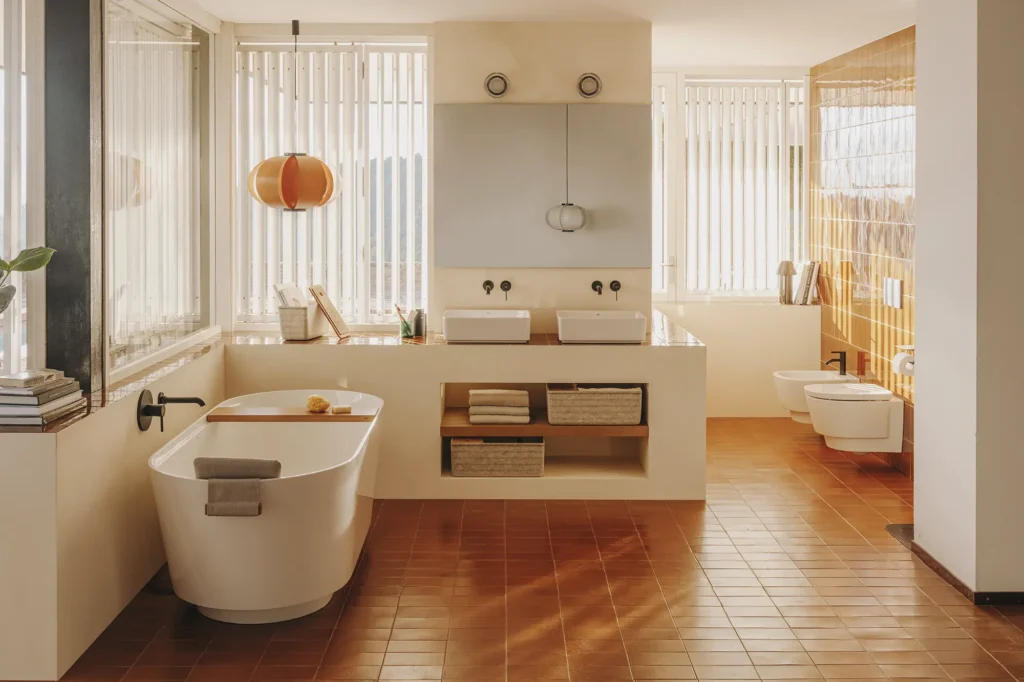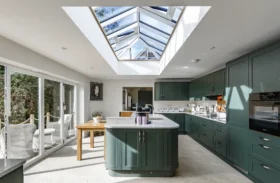
Early Bird Offer! Free tickets to meet independent experts at this summer's Build It Live
Save £24 - Book Now!
Early Bird Offer! Free tickets to meet independent experts at this summer's Build It Live
Save £24 - Book Now!Thinking about whether or not your home needs a bathroom renovation? Upgrading this space and rethinking the surfaces, layout and key design details can help improve its functionality and create a space you’ll feel excited to use.
If you’re undertaking a whole-house renovation, your dated bathroom is likely to be high on the rip-out-and-start-again priority list. While the perfect design might seem easier to attain if you’re building from scratch, working with a pre-set piping arrangement needn’t be too great a challenge, and there are plenty of ways you can improve the space that won’t involve too much hassle.
So, what’s involved when planning, designing and undertaking a bathroom remodel? From layouts to lighting, here you’ll find all the key information to ensure a well-planned scheme that suits your lifestyle, budget and design preferences.
You’ll need to have a thorough understanding of how major the bathroom renovation project is so that you can budget accordingly. Think about what’s currently in the bathroom – does the whole space need to be gutted or can anything be salvaged; is it just a case of an aesthetic update or does any of the plumbing need to be replaced to cater to your bathroom renovation ideas?
Another thing to bear in mind is whether the water pressure is strong enough for a good shower or if you may need to fit an additional pump. Draw up a list of things that you’d like to improve or change and shape your priorities around this.
Learn More: Bathroom Design: How to Plan an Effective Bathroom Layout & Scheme

Roca’s Tura collection has sustainability at the core of its design. It’s a timeless bathroom style that caters to both contemporary and period-style renovations – with WCs, sink basins, baths and storage systems for your bathroom upgrade
You should also check for obvious signs of water damage and leaks when undertaking a bathroom renovation. Common indications of a potential problem include: mildew or mould; disfigured, stained or warped floors, walls or ceilings below the room; and musty or earthy smells that persist even after a thorough clean.
Unfortunately, if you discover a leak then finding the source could mean ripping out and replacing more than you originally budgeted for; hence why understanding the scale of the project before you start to think about design details is so important.
Having a firm idea of how much you can afford to spend before you start shopping for individual tiles, fixtures and units will go a long way to helping you to focus your finances.
The best way to maintain the brand-new look of your bathroom is to reduce the potential effects of airborne moisture by making sure there’s efficient waterproofing and ventilation. If your bathroom update is part of a major house renovation then you may want to close up trickle vents and reduce the need to constantly open windows by installing a mechanical ventilation and heat recovery system (MVHR).

Mark Camillin and Liam Denny transformed this grade II listed home in Hampshire with a full renovation and two-storey extension. Inside the bathroom, the roof voids were exposed to show off the vaulted ceilings to their best effect, the interior scheme is simple yet sophisticated
These work by drawing damp, stale air outside, recycling the warmth from any moisture in the air and feeding a fresh, warm supply back into the home. If you’re working on a smaller project, simply installing a decent extractor fan should work wonders.
Heating is another core consideration – what is the current setup and can it be updated? Will a heated towel rail be enough to warm the whole room, for instance, and have you considered retrofitting underfloor heating?
Armed with a budget and an understanding of the work that’s needed, you can move onto the fun job of thinking about how you want the finished space to look. “Consider what you want to get out of the refurbishment as well as what don’t you like about the current room. Does the layout need to change dramatically; is there enough storage space and, if not, which areas are the most prone to clutter?” says Georgina Spencer from Roca Group.
Look at the space and think carefully about where everything should be positioned and whether that fits the current pipework layout. Start with the essentials (toilet, shower/bath and sink) and base the rest of the scheme around these.
“There aren’t the same specific zoning rules for bathroom designs as there are for kitchen configurations, as there are so many options. However, there are certain dimensions that need to be followed,” says Georgina.

Alison Maxwell was keen to create a playful and inviting space for her family when renovating her Victorian terrace property. The main bathroom boasts a colourful cement tile floor, vivid yellow window frames and bold floral wallpaper. Photo: Simon Maxwell
“As a general rule, leave 760mm from the front edge of all fixtures free of obstacles.” Following this rule will ensure there’s enough space to move around the bathroom easily and means it won’t feel cramped.
Also consider who is going to be using the room and how your family’s needs might change in the future. For example, is there enough room for a wheelchair to turn?
When it comes to planning the sequence of work, get the infrastructure in place, then start at the top of the room and make your way down to reduce the risk of damaging materials. There’s no point in fitting expensive new floor tiles if you’ve still got to paint the ceiling, for instance.
Read More: Complete Guide to Flooring For Your Home
Once you have a firm idea of the most suitable layout for your bathroom, you can get stuck into style choices. Deciding whether to go traditional or contemporary will be largely based on the look of the rest of the house. You should also think about how to achieve an appearance that isn’t going to date.
“Play it safe by drawing upon the simple styles of the 1920s-1950s, or those from earlier periods, by opting for heritage touches, such as ornate taps,” says Adam Chard from VictoriaPlum.

As part of their cottage renovation, Martin and Julie Smart created their vanity unit by upcycling an old family dressing table and then fitting a basin from CP Hart on top. The geometric floor tiles are from Fired Earth
The wet nature of a bathroom lends itself to moisture-resistant materials. Ceramic and/or porcelain tiling is an obvious choice, but anti-mould paint and water-resistant wallpaper are also popular options. Don’t assume you have to avoid fabrics – there are plenty of suitable bathroom blinds out there, for example.
Solid wood flooring isn’t ideal for wet zones because of its sensitivity to humidity, which can cause movement, but stable engineered varieties are an attractive alternative. Vinyl, stone, rubber and even polished concrete are all favoured surfacing choices, too.
CLOSER LOOK Adding a touch of luxury to your bathroom renovationMuch like other areas of the home, the way that we interact with our bathrooms is changing. While it will always remain a functional zone, the rise in popularity for achieving the same indulgent grandeur found in hotels and spas is encouraging more and more homeowners to create their own retreat-like haven, ideal for relaxation. This doesn’t just apply to large bathrooms and big budgets – opulence can be brought to compact zones and even wetrooms, too, given the right design.
Spacious countertops, waterfall showers, freestanding baths, seating areas, integrated music systems and smart controls – these are just a few examples of the kind of additions that could create the ultimate space for personal sanctuary and advanced usability. “It’s now easier than ever to replicate the look and feel of a spa in your own home,” says Adam. “Multi-functional showers with different outlets allow you to experience various sensations, plus a greater choice of lighting options means you can really set the mood without having to reach for the candles.” |
Bathrooms are often the preferred place for grooming and beautifying, which is why a mirror above the basin is a key part of most schemes, but remember that lighting is also important for this. For optimum illumination you need to direct brightness out from the mirror surround towards the person – units with built-in lights are great for this.
Lighting can also be used to enhance the overall ambience of a room, whether that means including a dimmer switch that can be turned down if you’re enjoying a rejuvenating bath or creating a focal feature with an ornamental fitting.
More Essential Advice: Lighting Design: The Ultimate Homeowner’s Guide

MW Architects created a striking bathroom that contains both contemporary and mid-century design features. The reeded glass partition wall sections the bathing area off from the sink units, creating defined spaces that offer privacy and functionality. Photo: French + Tye
“Our first ever collection of decorative lighting has been designed to provide the finishing touch to a variety of schemes and add character to a space that can sometimes appear clinical,” says Emma Gaskell from Frontline Bathrooms.
Take note of the growing trend for living room style bathrooms and luxury-led design by making your lighting into a focal feature. Flush ceiling fittings, elegant chandeliers and/or bar spotlights are all stylish solutions for an attractive centrepiece.
More Inspiring Ideas: Bathroom Ideas: Clever Bathroom Designs For Your Self Build or Renovation


Comments are closed.